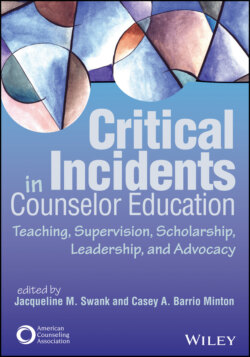Читать книгу Critical Incidents in Counselor Education - Группа авторов - Страница 75
Critical Incident Response
ОглавлениеMark B. Scholl
The author made a cogent case for providing students with a climate characterized by egalitarian dialogue to promote a transformative expansion of consciousness for learners (Freire, 1970). This recommendation is echoed by counselor educators (e.g., Dollarhide et al., 2018) who assert that egalitarian teacher-student dialogue facilitates the incorporation of social justice principles into counselor training. Similarly, Lai et al. (2014) noted the importance of egalitarian conversations in multicultural counseling courses and related training, emphasizing the importance of providing factual information and experiential learning consistent with the MAP.
It is important for Professor Malcom to inform students of ground rules for the classroom and his rationale for emphasizing dialogue. I agree that growth in cultural competence cannot occur if one maintains a sense of comfort. The concept of creating brave spaces complements the author’s recommendations (Arao & Clemens, 2013). Creating a classroom environment in which students openly share their authentic experiences, beliefs, and feelings requires courage, and this should be identified as an aspirational value. At the same time, it is helpful to provide students with ground rules to promote mutual respect and civility. A typical ground rule for brave spaces prohibits making personal attacks (i.e., criticizing individuals rather than behaviors; Arao & Clemens, 2013).
The author effectively contrasted students who are naive and students who have experienced oppression in their everyday lives. When Professor Malcom corrected Anne, the naive students were inclined to believe that he did not respect their opinions. By contrast, Bell, a student who had experienced oppression, believed Professor Malcom had gone too easy on Anne. These widely differing perspectives illustrate the considerable skill and experience needed to effectively lead egalitarian consciousness-promoting discussions (Williams, 2019).
The author aptly emphasized and addressed the difficulty of balancing the needs of both groups of students. I also appreciated how he distinguished between feeling unsafe and feeling uncomfortable. Instructors of multicultural courses can normalize and validate feeling uncomfortable by noting three common reasons for these feelings (Williams, 2019): (a) Counseling students are caring people who want to avoid offending others, (b) students with firsthand experiences of oppression may find these experiences particularly difficult to talk about, and (c) counseling students are highly invested in their own growth and development. Sharing these reasons can normalize feelings of discomfort, self-consciousness, and reticence.
Students from diverse populations can feel an unfair expectation to educate their more naive peers. I believe an important point can be added about Paolo Freire’s (1970) philosophy of education. Freire advocated for empowering students from oppressed populations to openly share their authentic inner voices and opinions, including opposing viewpoints, with classmates. Professor Malcom might have spent more time talking in depth with Bell about the classroom climate he envisions and how much her authentic responses can contribute. I believe it is important for Professor Malcom to balance encouraging Bell to share her authentic perspective with showing empathy regarding her feelings of safety. It is difficult to know precisely how Bell is feeling. Inviting Bell to share her feelings outside of class would provide an opportunity to practice sharing her authentic inner voice and might also increase her comfort in the classroom. Because many people of color feel an unfair expectation to educate white peers, it is important that Professor Malcom clearly communicate that he is extending an invitation that Bell has permission to decline.
Overall, the author provided clear, coherent recommendations for meeting the needs of students. The MAP is an excellent way to promote learning that can be tailored to the unique needs of individual learners. The author’s recommendations for using authentic, egalitarian practices to empower students also reflect attitudes and practices that will empower future clients.
• • •
